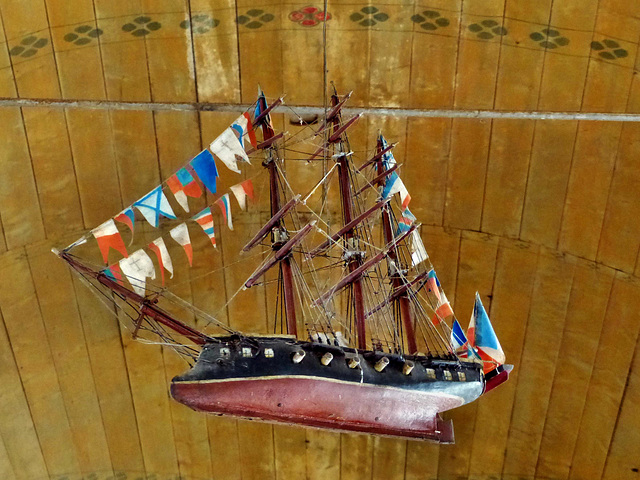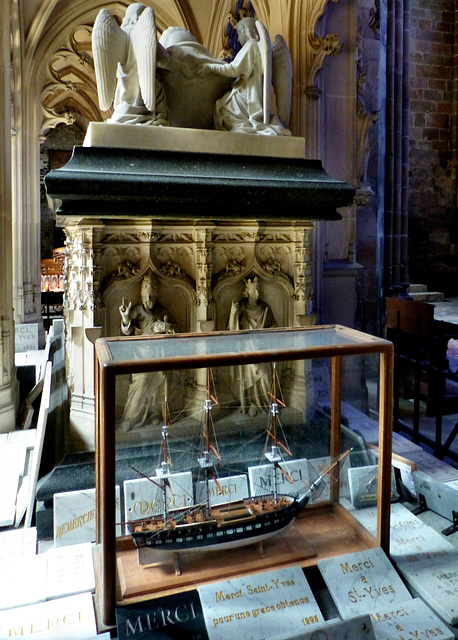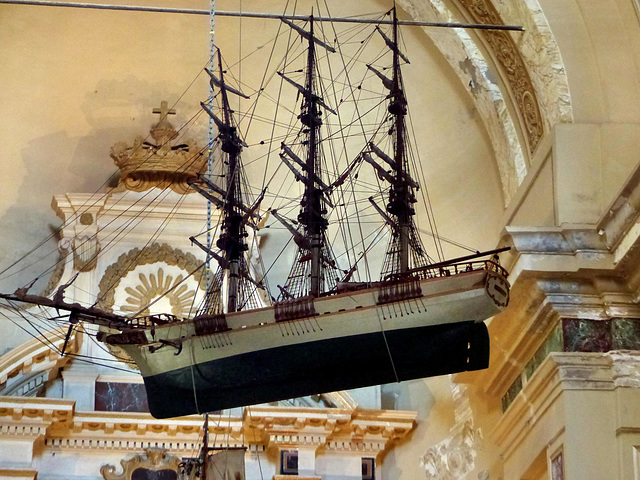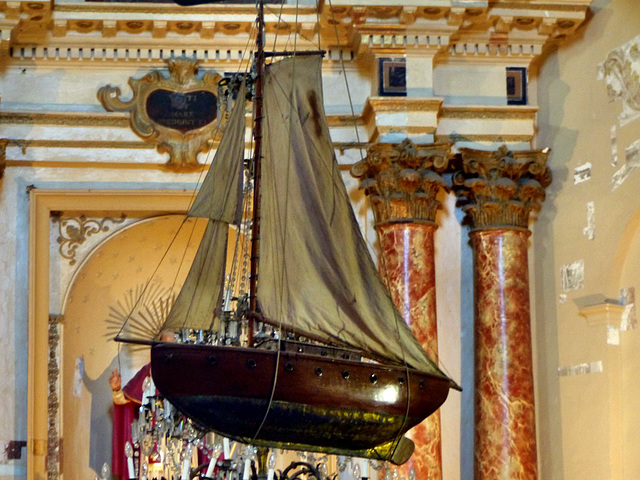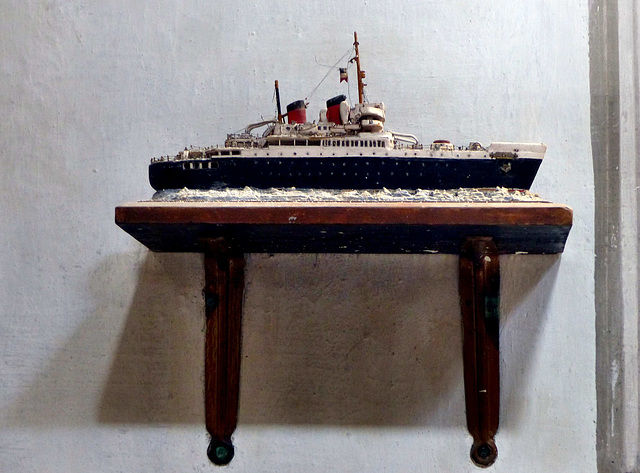
Church Ships
Votive ship models in churches.
Lanloup - Saint-Loup
The church, dedicated to Saint-Loup, patron saint of the parish, is surrounded by a small cemetery. The original building dates from the 13th century. This got got replaced in the 15th century. Around 1550 the porch and the transept were added.
A votive ship model under the ceiling of the nave.
Tréguier - Cathédrale Saint-Tugdual
The Welsh monk Saint Tugdual (of Tréguier) founded a monastery here in 535. Soon later Saint Tugdual was named "Bishop", though this may have been rather an "Abbot", as it took Tréguier to 848 to became a real bishopric. Soon after the Normans invaded the area, looted and ravaged the church and the town around, so that for decades there was no Bishop here. Around 970 the building of a new Romanesque cathedral started, of which only some pillars and the left tower still exist. Strange that this tower is named "Tour Hasting" after the leader of the Norman troops, who had destroyed the town a century ago. The cathedral may have been completed around 1100.
Work on today's Gothic building began in 1339 and lasted until the middle of the 15th century. The southern transept tower with its pierced top was not completed until 1785.
During the French Revolution, the diocese of Tréguier was dissolved.
The cathedral was sacked by of revolutionaries and converted into a horse stable.
In 1801 it returned to being a place of worship. The cathedral was restored and Prosper Mérimée took an active part in the cathedral's rebuilding process.
As Saint Tugdual is one of the seven founding saints of Brittany, who all came from Britain, Tréguier is one stage of the "Tro Breizh" a pilgrimage, known since the 13th century, linking the towns of the seven saints.
Here is even a votiv ship, floating in sea of other votivs.
Bénodet - Saint-Thomas
In Bénodet existed a priory founded probably in 1231. The chapel was built at the end of the thirteenth. It was dedicated to Saint Thomas of Canterbury.
This small church is one of the oldest Gothic structures in Brittany. Of couse it got rebuilt and enlarged a couple of times. Last time after the bell tower was collapsed during a storm in 1836. While the widened nave is from the 15th the choir, seen here, is 13th century.
As Benodet had a commercial port trading fish in exchange for wine with the Bordeaux area it is not a surprise to find a votive chip here. It seem, that the church ship is squatted by a giant sea gull.
Cologne - St. Ursula
Cologne is the fourth-largest city in Germany - and one of the oldest. A Germanic tribe, the Ubii, had a settlement here, this was named by the Romans "Oppidum Ubiorum". In 50 AD, the Romans founded "Colonia Claudia Ara Agrippinensium", the city then became the provincial capital of "Germania Inferior".
Archaeological excavations revealed a building from the fourth century, this got converted and extended in the 6th century.
The Roman cemetery, on which St. Ursula was built, had been rummaged through in the 12th century in search of relics, as this church is connected to the legend of St. Ursula. According to this legend Ursula was on her way up the Rhine with eleven companions. Over the time this number changed to 11.000 virgins, as there were so many skeletons on this cemetery and the reliquary trade in the Middle Ages. They reached Basel from where they made a pilgrimage on foot to Rome. Pope Cyriakus joined them on their return journey. In Mainz Ursula's bridegroom Aetherius was finally baptized and from there the company reached Cologne, which was besieged by the Huns. Since the 11(000) virgins refused to marry the non-Christian Huns, they were murdered.
The church was damaged by the raid of the Normans in Cologne in 881/882. In 922 nuns from Gerresheim fled to Cologne from an invasion by the Hungarians and settled here.
When in 1106 the city fortification was extended and another large cemetery was discovered. The rich finds and the trade with relics led to prosperity, so that a complete new construction of the church became possible.
The tower was completed around 1230. Mid 13th century the large Gothic choir, that was only used by canons and nuns, was added. Towards the end of the 15th century, the church underwent extensive renovations.
In 1802 the convent was dissolved and since 1804 the church serves the parish. At that time St. Ursula was in a desolate condition and got partially restored. End of the 19th century the church got finally rebuilt, but in 1945, after WWII, St. Ursula was a ruin.
The rebuilding was completed in 1978, when the "Goldene Kammer" ("Golden chamber" was reopened. Seen here is the narthex.
This model of St. Ursula´s boat is on display. Note the 11 "flames" on the sail. They stand for the 11(000) companions of St. Ursula. Cologne´s coat of arms has these 11 flames as well.
Ajaccio - St. Erasme
Ajaccio was a seat of a diocese, mentioned by Pope Gregory the Great in 591. Excavations proved the existence of a baptistry and a cathedral from the 6th century, but not much is known about the early medieval times. The settlement did not prosper and shrunk down until the Genoese, eager to assert their dominance in the south of the island, decided to refound and rebuild the city of Ajaccio in 1492.
Although at first populated exclusively by the Genoese, the city slowly opened to the Corsicans. Ajaccio was occupied from 1553 to 1559 by the French but fell again to the Genoese later.
Genoa was strong enough to keep Corsica until 1755, the year Pasquale Paoli proclaimed the Corsican Republic. Paoli took most of the island for the republic but he was unable to force Genoese troops out of the citadels at the coast, Ajaccio was one of them.
French troops entered Corsica in 1768 and in 1780 the island was was formally annexed to France in 1780.
Napoleon Bonaparte was born in Ajaccio (as Nabulione Buonaparte) in 1769. His father had been the secretary to Pasquale Paoli during the Corsican Republic. His father was offered an appointment for his son to the Military College of Brienne, but the child had to be under 10. This is where the dispute about Napoleon´s age starts, as the records at Ajaccio have been altered and it may well be, that Napoleon was born in Corte in 1768. Anyway, he went to Brienne from 1779–1784 and started his career.
The church was erected in 1622 by Jesuits and dedicated to Saint Ignatius of Loyola. After the Jesuits had to move out the church got dedicated to St. Erasmus, who is the patron of seamen. Since then the church is as well known as " L'église des marins".
I knew, that inside are many ex-votos in form of "church ships", but as people were preparing for a funeral, I was not allowed in so I could only take two photos, before they had pushed me out - and locked the doors. This is one of them.
Ajaccio - St. Erasme
Ajaccio was a seat of a diocese, mentioned by Pope Gregory the Great in 591. Excavations proved the existence of a baptistry and a cathedral from the 6th century, but not much is known about the early medieval times. The settlement did not prosper and shrunk down until the Genoese, eager to assert their dominance in the south of the island, decided to refound and rebuild the city of Ajaccio in 1492.
Although at first populated exclusively by the Genoese, the city slowly opened to the Corsicans. Ajaccio was occupied from 1553 to 1559 by the French but fell again to the Genoese later.
Genoa was strong enough to keep Corsica until 1755, the year Pasquale Paoli proclaimed the Corsican Republic. Paoli took most of the island for the republic but he was unable to force Genoese troops out of the citadels at the coast, Ajaccio was one of them.
French troops entered Corsica in 1768 and in 1780 the island was was formally annexed to France in 1780.
Napoleon Bonaparte was born in Ajaccio (as Nabulione Buonaparte) in 1769. His father had been the secretary to Pasquale Paoli during the Corsican Republic. His father was offered an appointment for his son to the Military College of Brienne, but the child had to be under 10. This is where the dispute about Napoleon´s age starts, as the records at Ajaccio have been altered and it may well be, that Napoleon was born in Corte in 1768. Anyway, he went to Brienne from 1779–1784 and started his career.
The church was erected in 1622 by Jesuits and dedicated to Saint Ignatius of Loyola. After the Jesuits had to move out the church got dedicated to St. Erasmus, who is the patron of seamen. Since then the church is as well known as " L'église des marins".
I knew, that inside are many ex-votos in form of "church ships", but as people were preparing for a funeral, I was not allowed in so I could only take two photos, before they had pushed me out - and locked the doors. This is one of them.
Nonza - Santa Giulia
The island of Corsica is one of the 18 regions of France. It was colonized the Carthaginians, the Greeks, the Etruscans and the Romans. After the Roman empire collapsed, Corsica got invaded by the Vandals and the Ostrogoths. For a short while the island belonged to the Byzantine Empire, then the Franks granted the island to the Pope, in the early 11th century Pisa and Genoa together freed the island from the threat of Arab invasion. The island came under the influence of the Republic of Pisa, later it belonged to Genua for centuries. In 1755 after a long fight for independence from Genoa the independent Corsican Republic was proclaimed, but in 1769, when the island was conquered by France. As the areas near the coast over centuries have been threatened by attacks and raids of pirates many old hamlets and dwellings are wide inland, high in the mountains. So most of the old churches are in the mountains and some of them are hard to find.
Nonza is located on a cliff, towering a hundred meters over the sea. Santa Giulia (corse: Santa Ghjulia) is the the center of the village. Legends tell that in 303 a girl named Guilia was martyred here. In 734 the Saracens burnt down settlement including the old sanctuary. The following church of the 9th century got replaced within the 13th century, but this church got rebuilt in classical style around 1575. It got renovated and remodeled within the 19th century. Obviously sailors and fishermen once lived in Nonza, so there is a church-ship here ro ensure a save return. Ocean-liners like this one are very rarely seen in churches.
Santa Maria di Leuca - Santa Maria de Finibus Terrae
The Punta Meliso promontory is, where the heel of the Italian boot ends. Here is the "Basilica di Santa Maria de Finibus Terrae", erected where once a Roman temple stood and where St. Peter on his way to Rome made a stop. So the place developed into a place of worship and pilgrimage in the ancient and medieval age.
The current fortified structure of the church was built between 1720 and 1755 to resist the numerous and repeated attacks by Turkish and Saracen invaders. Probably many sailors praid here. One captain left this church ship.
Lübeck - St. Jakobi
The area around Lübeck, today a large city with a population of more than 200,000, had been settled by Slavs since the 7th century. Slavs had a settlement north of the present city called "Liubice", which was razed by the pagan Rani tribe in 1128.
15 years later Adolf II, Count of Schauenburg and Holstein, founded the modern town as a German settlement on the river island of Bucu. He built a new castle, first mentioned as existing in 1147. Adolf II had to cede the castle to the Duke of Saxony, Henry the Lion, in 1158. After Henry's fall from power in 1181, the town became an Imperial city. Emperor Barbarossa ordained that the city should have a ruling council of 20 members. With the council dominated by merchants, trade interests shaped Lübeck's politics for centuries.
In the 14th century, Lübeck became the "Queen of the Hanseatic League", being by far the largest and most powerful member of that medieval trade organization. In 1375, Emperor Charles IV named Lübeck one of the five "Glories of the Empire", a title shared with Venice, Rome, Pisa, and Florence.
Conflicts about trading privileges resulted in fighting between Lübeck (with the Hanseatic League) and Denmark and Norway – with varying outcome. While Lübeck and the Hanseatic League prevailed in conflicts in 1435 and 1512, Lübeck lost when it became involved in a civil war that raged in Denmark from 1534 to 1536. From then on Lübeck's power slowly declined. The city remained neutral in the Thirty Years' War, but the devastation from the decades-long war and the new transatlantic orientation of European trade caused the Hanseatic League – and thus Lübeck with it – to decline in importance. However, Lübeck still remained an important trading town on the Baltic Sea.
-
The present three aisle church was erected around 1300 and replaced a Romanesque hall church on the same site after the great city fire of 1276, which was already mentioned around 1227.
The Jakobikirche was consecrated in 1334 as a church of sailors and fishermen. St. Jakobi was one of the few Lübeck churches to remain undamaged during the bombing raid on Palm Sunday night in 1942.
In the tower chapel of St. Jacobi there is a memorial to the sinking of the "Pamir", a four-masted barque.
On 21 September 1957, she was caught in Hurricane Carrie and sank off the Azores. 80 of the Pamir's 86 crew members lost their lives.
Jump to top
RSS feed- Latest items - Subscribe to the latest items added to this album
- ipernity © 2007-2024
- Help & Contact
|
Club news
|
About ipernity
|
History |
ipernity Club & Prices |
Guide of good conduct
Donate | Group guidelines | Privacy policy | Terms of use | Statutes | In memoria -
Facebook
Twitter

